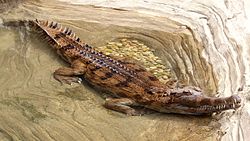Tomistoma
| False gharial Temporal range: Oligocene - Quaternary |
|
|---|---|
 |
|
| False gharial, Tomistoma schlegelii | |
| Scientific classification | |
| Kingdom: | Animalia |
| Phylum: | Chordata |
| Subphylum: | Vertebrata |
| Class: | Reptilia |
| Order: | Crocodilia |
| Family: | Gavialidae |
| Subfamily: | Tomistominae |
| Genus: |
Tomistoma Müller, 1846 |
| Species: | T. schlegelii |
| Binomial name | |
|
Tomistoma schlegelii (Müller, 1838) |
|
 |
|
| Range of Tomistoma schlegelii | |
The false gharial (Tomistoma schlegelii ), also known as Malayan gharial, Sunda gharial and Tomistoma, is a freshwater crocodilian native to Peninsular Malaysia, Borneo, Sumatra and Java. It is listed as Vulnerable on the IUCN Red List, as the global population is estimated at fewer than 2,500 mature individuals.
The specific name schlegelii honors the German herpetologist Hermann Schlegel.
Unlike the gharial, the false gharial's snout broadens considerably towards the base and so is considerably more similar to those of true crocodiles than the gharial, whose osteology indicates a distinct lineage from all other living crocodilians. However, preliminary nuclear genetic sequences may indicate the gharial and false gharial had a shared ancestor at some point in prehistory. Other molecular studies have similarly indicated that it is the nearest relative (the sister taxon) of the gharial. Along with close fossil relatives, such as Maroccosuchus, it is thus increasingly classed in the family Gavialidae.
The false gharial is dark reddish-brown above with dark brown or black spots and cross-bands on the back and tail. Ventrals are grayish-white, with some lateral dark mottling. Juveniles are mottled with black on the sides of the jaws, body, and tail. The smooth and unornamented snout is extremely long and slender, parallel sided, with a length of 3.0 to 3.5 times the width at the base. All teeth are long and needle-like, interlocking on the insides of the jaws, and are individually socketed. The dorsal scales are broad at midbody and extend onto the sides of the body. The digits are webbed at the base. Integumentary sensory organs are present on the head and body scalation. Scales behind the head are frequently a slightly enlarged single pair. Some individuals bear a number of adjoining small keeled scales. Scalation is divided medially by soft granular skin. Three transverse rows of two enlarged nuchal scales are continuous with the dorsal scales, which consist of 22 transverse rows of six to eight scales, are broad at midbody and extend onto the sides of the body. Nuchal and dorsal rows equals a total of 22 to 23 rows. It has 18 double-crested caudal whorls and 17 single-crested caudal whorls. The flanks have one or two longitudinal rows of six to eight very enlarged scales on each side.
...
Wikipedia

